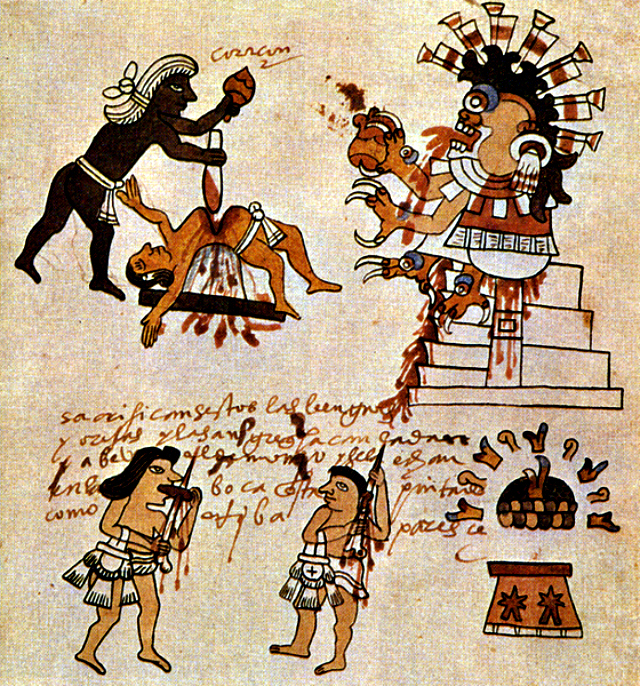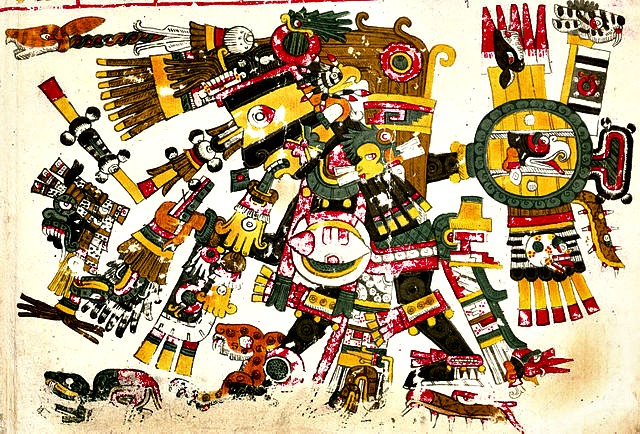
10 Aztec sacrifice facts – Human Sacrifices

The Aztecs were a powerful and dominant society that lived in central Mexico from the 12th to the 14th century. They built a civilization with highly educated and skilled people, complex infrastructure and architecture and a sophisticated political system. However, what most people today know the Aztecs for is the practice of human sacrifice. In this article, we will explore 10 bloodthirsty facts about the ritual that was steeped in religion and mythology.
Add a comment to this Aztec sacrifice video here.
1. The Aztecs were not the only culture to perform human sacrifice.

Human sacrifice was performed by many South American cultures at this time, including the Mayans. Aztecs are particularly well known for it because of the large amount of victims that were subjected to death this way in their society. Every Aztec year had 18 festivals, and human sacrifice was central to the festivities at each of these.
2. Human sacrifice was performed to stop the universe collapsing.

The Aztecs believed that the universe would collapse after 52 years unless the gods were fed and kept strong. Human sacrifice was performed as a ritual and offering to the gods with the intention of allowing the universe to survive and thrive. To mark the 52-year cycle, a New Fire Ceremony was performed where all fires were put out at midnight and human sacrifices were made. The Aztecs would wait until dawn hoping that the sun would rise again and the sacrifices had been sufficient. The universe could then continue for 52 further years without risk of collapse.
3. The Aztecs sacrificed their own people.

The flower wars were ritual wars conducted to select human sacrifice victims from the Aztec people themselves. The wars would be between the different cities within the Aztec empire and the warriors were mostly volunteers. Instead of being killed on the battlefield, the aim was to take prisoners – these prisoners would then be sacrificed as payment to the gods.
4. A beating heart would be taken from the victim.

Huitzilopochtli was the main god that the Aztecs worshiped and was depicted as a dragon. He was believed to be a manifestation of the sun. The sacrificial victim would be placed on a stone and would have his chest and stomach cut by the priest. The heart would then be taken out of the body as it was still beating. It would be held upwards in a gesture of offering to Huitzilopochtli. The dead body would be cut up and given to people as a gift; it is thought these pieces were then eaten. If the victim had been captured in battle then the warrior responsible for the capture would rise up the hierarchy.
5. Human sacrifices would be made in gladiatorial combat.

Tezcatlipoca was believed to be a very powerful and dangerous god. He was the god of the night and was able to perform and control magic. His name meant smoking mirror. He had the ability to forgive and to heal illness but he was a dark god and would often use his powers to cause illness and was responsible for natural disasters such as famine or floods. The Aztecs believed that Tezcatlipoca fed off the victims of war so when people were sacrificed to him, it was in a staged gladiatorial fight. The victim would be given a pretend weapon and expected to fight against four heavily armed warriors. Tezcatlipoca had a month dedicated to him. At this time a young man would be selected to be a living incarnation of the dark god. He would be dressed, fed and treated like a god until the end of the month when he would climb the temple steps and offer his body to be sacrificed.
6. Human sacrifice victims would be burnt alive.

Museo Nacional de Antropología, Mexico City. Image credit: Xuan Che cc2.0
Huehueteotl was the fire god. When sacrificing to him, the community would eat a rich feast and then set the victims on fire. The burning people would be removed from the fire before death and their hearts would be cut out. The Aztecs believed if they didn’t offer sacrifices to Huehueteotl, their city would be set on fire.
7. Children were sacrificed.

Tlaloc was the god of water and rain. The Aztecs were afraid that if they made Tlaloc angry he would stop the rain which would dry up their crops and cause disease. They believed that the Tlaloc wanted the tears of children so it was the young who were sacrificed to him and they would be made to cry before the sacrifice ritual was performed.
8. Not all sacrifice was fatal or human.

Other religious sacrificial practices took place, this included bloodletting. This was the process of self-harming to allow large amounts of blood to be shed without death occurring. The sentiment of offering this blood to the gods was the same as sacrifice. The Aztecs also killed snakes, deer and even butterflies for the same reason. They also created images of the gods using dough that was mixed with human blood and honey. In a religious ceremony these sculptures would be “sacrificed” and then either burnt or eaten.
9. The fall of the Aztecs can be partly attributed to the practice of human sacrifice.

Unknown artists; Mexico; second half of 17th century; oil on canvas. Representing the 1521 Fall of Tenochtitlan, in the Spanish conquest of the Aztec Empire. Jay I. Kislak Collection; Rare Book and Special Collections Division (26.2).
There are many reasons for the Aztec defeat at the hands of the Spanish in 1521, one of which was the ritual of human sacrifice. Firstly, this bloodthirsty practice made them many enemies among neighbouring tribes. These other tribes formed alliances with the Spanish and helped them defeat the Aztecs. It is also thought that the high number of human sacrifices made each year (up to 20,000) physically affected their chances of success because they simply had fewer people than they could have had to offer a better resistance.
10. The practice of human sacrifice helped the Aztecs understand Christianity.

When the Spanish had conquered Mexico, they wanted to convert the country to Christianity. They saw the Aztec religion as barbaric and misguided. They tore down temples and built churches in their place. They also built a monastery where Spanish priests and monks would actively work to preach the word of the Bible. On the surface, it appeared that the religions were very different but the Aztec people were able to see similarities between the two, most notably how God sacrificed his only son Jesus for the sins of all men. The Aztecs understood this concept and compared it to their own history of sacrifice. It enabled the conversion to Christianity to take place with less resistance than expected.
TO LEARN MORE ABOUT THE AZTECS:
- Ten Essential Facts You Need to Know About the Aztecs!
- Eight Reasons the Aztecs Lost Their Empire.
- Aztec Civilization Timeline.
- 10 Most-Asked Questions About the Aztecs!
AZTECS! Video Playlist.
A detailed playlist of the videos is listed below.
The Playlist:
- Summary of Aztecs – Aztec Essentials in 86 seconds by IP Factly
- 10 Aztec Sacrifice Facts – Aztec Human Sacrifice Essentials in 120 Seconds by IP Factly
- The Aztec Empire Summary – by Sandra Alvarez
- Aztec Empire & Culture Interesting Facts, Anthropology 1 by PsycheTruth
- Aztec Empire & Culture Interesting Facts, Anthropology 2 by PsycheTruth
- Aztec Civilization by LearningHelp
- Tenochtitlan (The Impossible City) by John Fitz
What do you know?
Think you remember what you’ve read? Try out the Aztec Human Sacrifice Trivia Quiz!
Sources:
http://www.ancient.eu/Aztec_Sacrifice/
http://www.bbc.co.uk/education/clips/zyfygk7
http://en.wikipedia.org/wiki/Human_sacrifice_in_Aztec_culture





It was religion and The Aztec were very feared also all of that is correct they did sacrifice but the Aztec weren’t the only Empire “tribes” To do sacrifice Ceremonies they were just one of them.
they so dum
The hell were they doing???
the pickle i just ate was very big an large
I bet
cool:)
good
awesome
amazing
wow 🙂
im an aztec
SWEET WAS YOU SACRIFACED
That is so funny!!!!
i think this website was a very informative place where i could get important and cool facts about the aztecs and their ways of sacrificing! i had a project on this topic and i used this site as a reference because of the great information it had. i’d rate in 5 stars!
wow I had no idea
there is something wrong with these people
Sirusly
Very informative
WHAT ON EARTH?!!?!?!?
Omaygad?????
mmmmmm
This is Madness! Madness? this is Sparta!
they are so dum
*dumb
So much gore ?
😀
Crazy
illuminatie conmfirmed
Funny
They so awfull
yup
cuters 🙂
Crazy